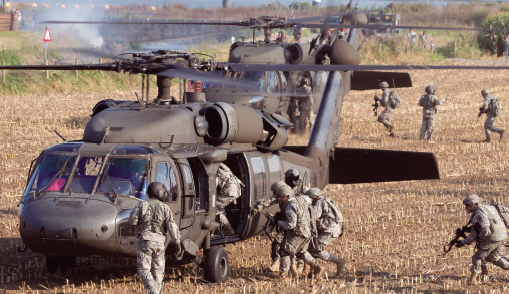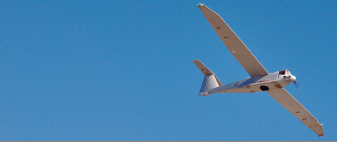Today, the Department of Defense (DoD), other Government organizations and Commercial Industries, continue to manage strict spending conditions that affect their ability to meet current and future communications requirements.

This is especially challenging for Airborne communications. We are now in an era where Commercial-Off-The-Shelf (COTS) products are created using the newest technologies and service offerings. Turning attention to these COTS solutions will not only help the economy, but also improve production and the ability to address rapid response needs.
To further compound the difficulty of today’s continued budget restrictions, the demand for immediate access to critical data requirements (e.g., streaming full-motion-video) and mission capabilities are still growing at exponential rates. Specifically, there is a relevant likelihood that higher data rates requiring advancing technologies could further hinder progress in execution of operational missions if not addressed by more open-system architecture leveraging COTS systems affording the most ongoing flexibility and scalability.
The alternative is more expensive, slow-to-market, stovepipe solutions that more often than not result in one-off solutions that handicap the tactical users. The commercial solutions provide an advantage getting the most out of your Airborne Communications without limiting any future requirements and changes, which are not necessarily known today.
The recent conflicts in Afghanistan and Iraq have taught us a tremendous amount regarding the ongoing demands requiring flexible and scalable communications. Todays engagements are predominantly grounded in multiple austere locations necessitating a continual and dominant need for secure network communications. Advancing Airborne SATCOM-On-The-Move (SOTM) capabilities are now a “must-have” for operations supporting our warfighters in these challenging areas.
Airborne networks carry high value tactical information and sensor data packages between multiple aircraft and ground deployments, while providing an extension to the region of operation for protected communications our troops operating in adversarial environments. Just as the warfighter is the difference maker for our way of life back here in the United States, the delivery of high value intelligence and tactical information is the difference maker to ensuring the security and safety of our warfighters.
While the evolution of intelligence-based Communications-On-The-Move (COTM) established itself as a dominant force in and during ongoing defense operations in Afghanistan, the application is continuing to pivot to a more global posture. Airborne Communications are also increasingly in demand, even expanding to the commercial industries in aviation, security protection and extending a corporate wide area network to the sky.
Today, open-system commercial systems and technologies are leading the way in the advancement of Airborne communications from commercial grade satellites to the mature mission systems equipment onboard our Airborne fleets. COTS equipment has more dedicated organizations and efforts being put forth to establish technology roadmaps and deliver on them in order to avoid the need for updates as soon as solutions are deployed.
As technology rapidly advances at an expedited rate, continuing to deploy open COTS systems provides the end-user with the best ability to leverage advanced systems and network communications vs. closed and one-off custom solutions of the past that should remain in the past.
Modern technologies are primarily based on commercial open architecture. The wide array of antenna systems for Airborne communications has only grown in the last decade. Even with the complexity that is introduced by fast moving air vehicles 10’s of 1,000’s of feet off the ground—technology advancements within the commercial space continue to meet the increasing demands, showing no signs of slowing down. With new materials and scientific algorithms, what was once thought of as an “absolute” in the best-of breed technology a decade ago, is now seen as antiquated and surmountable.
Previous decades could rely on a small handful of options to choose from, whereas today we benefit from multiple options that introduce the highest value to the end-user through increased performance at a lower cost. However, one must concentrate on open system architecture to maintain a path within these technology advances.

Arcturus T-20 UAV in flight.
Open system architecture does not preclude the network and systems themselves from being secure. Today security is also at its highest demand and the COTS solutions are meeting those demands as well. There are even the highest-level security approved COTS-for-Classified systems and architectures that have been integrated in all elements of network topology, including Airborne communications. Commercial products do not prohibit a network requiring highly secure transmission from being able to do exactly that, it has been addressed and continues to progress.
Just as important are the new applications and verticals embracing and deploying Airborne communications for their operations. Smaller, more agile Unmanned Aerial Vehicles (UAV) and rotary wing vehicles are now being looked to more aggressively. Expanding the number of platforms that will carry intelligence-collection and surveillance systems for both military and commercial applications.
Both air vehicle platforms have their respective complex challenges; nevertheless can provide secure network reliability via SATCOM for high data rate applications (e.g. HD FMV). Utilizing smaller, Class III UAVs for Airborne based intelligence-collection missions will deliver the similar high value data packets as their bigger counterparts, but provides tremendous economics for the entry cost of the full air vehicle asset and longer endurance for more continual information consumption.
Additionally, rotary wing vehicles are being looked to for providing these mission capabilities and furthering the utilization of an important air vehicle asset for both the military and commercial customer. Rotary wing had always been seen as restricted from having the ability to provide high data rate applications through the rotor blades, which also has been overcome by open commercial technology.

CAT 350 ME Airborne.
The value proposition to employ open, commercial-based systems and network protocols (e.g., Ethernet) responds to significant cost reductions that meet present business needs, but do not preclude leveraging advances in the open systems for future requirements. With the removal of complex, resource-intensive proprietary systems, the end-user can soon remove the term legacy from being adjacent to his system architecture soon after its deployment. All while not compromising on maintaining the highest levels of security.
The desires of the DoD and Commercial business for uninterrupted access while on-the-move will not diminish, where, in fact, consumption will only multiply. Just as the ability to maintain and stay on budget, while delivering solutions within the fastest timeframe will sustain as a charter of those demanding these requirements. Commercial systems provide the leverage to stay ahead of technology advances without compromise on economics, security and performance.
Garr R. Stephenson Jr. heads up the Airborne Comms-On-The-Move business unit at UltiSat, Inc. UltiSat is a global SATCOM and network services company, providing innovative strategies for the growing demand of Airborne applications without compromise for security, scalability and flexibility. UltiSat is currently supporting Airborne COTM networks on manned Fixed Wing and UAV Programs for domestic and international customers.



